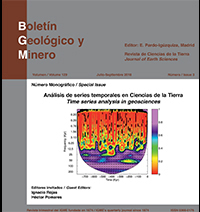Advanced analysis methods applied to reconstructed and simulated paleoclimatic time series
DOI:
https://doi.org/10.21701/bolgeomin.129.3.003Keywords:
paleoclimate, relaxation model, glacial oscillationsAbstract
The results of a simulated CO2 (C) and a global ice volume (V) time series, derived from a simple relaxation model of the glacial-interglacial cycles (García-Olivares and Herrero, 2013), have been analyzed using linear and non-linear techniques to evaluate the ability of the model on simulating the dynamics embedded on the climate system. On a first approximation, we have compared simulated time series with the corresponding paleoclimatic reconstructions, obtaining correlations of 0.88 between proxy-record δ18O (Lisiecki and Raymo, 2005) and simulated V, and 0.79 between reconstructed atmospheric CO2 concentration (Petit et al., 1999; Indermuhle et al., 2000; Monnin et al., 2001; Siegenthaler et al., 2005; Luthi et al., 2008) and simulated C. Spectral analysis using Fourier transform and continuous wavelet transform are useful tools to quantify the performance of a model for reproducing the dynamics embedded in reconstructed time series. The analysis shows that the model reproduces closely the dynamics embedded in the ice volume time series, but the coherence between the simulated and reconstructed CO2 is only sporadic, indicating that both time series do not follow the same dynamical behaviour, although in the deglacial periods the two carbon series become dynamically close. The analysis reinforces the hypothesis that some specific mechanisms included in the model are able to closely reproduce the glacial-interglacial oscillations and thus suggests which specific mechanisms should be more seriously investigated in the climate system. These techniques may be applied to other climatic time series to quantify the performance of a model simulating the dynamics of the climate system.
Downloads
References
Berger, A. 1978. Long term variations of daily insolation and quaternary climatic changes. Journal of the Atmospheric Sciences, 35(12), 2362-2367. https://doi.org/10.1175/1520-0469(1978)035<2362:LTVODI>2.0.CO;2
Bintanja, R., R. S. van de Wal, and Oerlemans, J. 2005. Modeled atmospheric temperatures and global sea levels over the past million years. Nature, 437, 125 - 128. https://doi.org/10.1038/nature03975 PMid:16136140
García-Olivares, A., and Herrero, C. 2012. Fitting the last pleistocene delta o-18 and CO2 time-series with simple box models. Scientia Marina, 76S1, 209-218. https://doi.org/10.3989/scimar.03617.19H
García-Olivares, A., and Herrero, C. 2013. Simulation of glacial- interglacial cycles by simple relaxation models: consistency with observational results. Climate Dynamics, 41(5-6), 1307-1331. https://doi.org/10.1007/s00382-012-1614-7
Grinsted, A., Moore, J., and Jevrejeva, S. 2004. Application of the cross wavelet transform and wavelet coherence to geophysical time series. Nonlinear Processes in Geophysics, 11, 561-566. https://doi.org/10.5194/npg-11-561-2004
Hays, J. D., Imbrie, J., and Shackleton, N. J. 1976. Variations in the earth's orbit: Pacemaker of the ice ages. Science, 194(4270), 1121-1132. https://doi.org/10.1126/science.194.4270.1121 PMid:17790893
Indermuhle, A., Monnin, E., Stauffer, B., Stocker, N. J. and Wahlen, M. 2000. Atmospheric CO2 concentration from 60 to 20 kyr BP from the Taylor Dome Ice Core, Antarctica. Geophysical Research Letters, 27(5), 735-738. https://doi.org/10.1029/1999GL010960
Lisiecki, L. E., and Raymo, M. E. 2005. A Pliocene- Pleistocene stack of 57 globally distributed benthic delta O-18 records. Paleoceanography, 20(1), PA1003. https://doi.org/10.1029/2004PA001071
Luthi, D., Le Floch, M., Bereiter, B., Blunier, T., Barnola, J. M., Siegenthaler, U., Raynaud, D., Jouzel, J., Fischer, H., Kawamura, K., and Stocker, T. F. 2008. High-resolution
carbon dioxide concentration record 650,000-800,000 years before present, Nature, 453(7193), 379-382. https://doi.org/10.1038/nature06949 PMid:18480821
Marwan, N., Romano, M. C., Thiel, M. and Kurths, J. 2007. Recurrence plots for the analysis of complex systems. Physics Reports, 438(5-6), 237-329. https://doi.org/10.1016/j.physrep.2006.11.001
Monnin, E., Indermuhle, A., Dallenbach, A., Fluckiger, J., Bernhard, S., Stocker, T. F., Raynaud, D., and Barnola, J. M. 2001. Atmospheric CO2 concentrations over the last glacial termination, Science. 291, 112-114. https://doi.org/10.1126/science.291.5501.112 PMid:11141559
Paillard, D. 2010. Climate and the orbital parameters of the Earth. Comptes Rendus Geoscience, 342(4-5), 273-285. https://doi.org/10.1016/j.crte.2009.12.006
Paillard, D., and Parrenin, F. 2004. The Antarctic ice sheet and the triggering of deglaciations. Earth and Planetary Science Letters, 227(3-4), 263-271. https://doi.org/10.1016/j.epsl.2004.08.023
Petit, J. R., Jouzel, J., Raynaud, D., Barkov, N. I., Barnola, J. M., Basile, I., Bender, M., Chappellaz, J., Davis, M., Delaygue, G., Delmotte, M., Kotlyakov, V. M., Legrand, M., Lipenkov, V. Y., Lorius, C., Pépin, L., Ritz, C., Saltzman, E., and Stievenard, M., 1999. Climate and atmospheric history of the past 420000 years from the Vostok ice core Antarctica. Nature, 399, 429-436. https://doi.org/10.1038/20859
Roulston, M. S. 1999. Estimating the errors on measured entropy and mutual information, Physica D: Nonlinear Phenomena, 125, 285-294. https://doi.org/10.1016/S0167-2789(98)00269-3
Siegenthaler, U., Stocker, T. F., Monnin, E., Lüthi, D., Schwander, J., Stauffer, B., Raynaud, D., Barnola, J. M., Fischer, H., Masson-Delmotte, V., and Jouzel, J. 2005. Stable carbon cycle-climate relationship during the Late Pleistocene. Science, 310, 1313-1317. https://doi.org/10.1126/science.1120130 PMid:16311332
Tziperman, E., Raymo, M. E., Huybers, P., and Wunsch, C. 2006. Consequences of pacing the pleistocene 100 kyr ice ages by nonlinear phase locking to milankovitch forcing. Paleoceanography, 21(4), PA4206. https://doi.org/10.1029/2005PA001241
Downloads
Published
How to Cite
Issue
Section
License
Copyright (c) 2024 Consejo Superior de Investigaciones Científicas (CSIC)

This work is licensed under a Creative Commons Attribution 4.0 International License.
© CSIC. Manuscripts published in both the print and online versions of this journal are the property of the Consejo Superior de Investigaciones Científicas, and quoting this source is a requirement for any partial or full reproduction.
All contents of this electronic edition, except where otherwise noted, are distributed under a Creative Commons Attribution 4.0 International (CC BY 4.0) licence. You may read the basic information and the legal text of the licence. The indication of the CC BY 4.0 licence must be expressly stated in this way when necessary.
Self-archiving in repositories, personal webpages or similar, of any version other than the final version of the work produced by the publisher, is not allowed.
Funding data
Agencia Estatal de Investigación
Grant numbers CTM2011-28867















